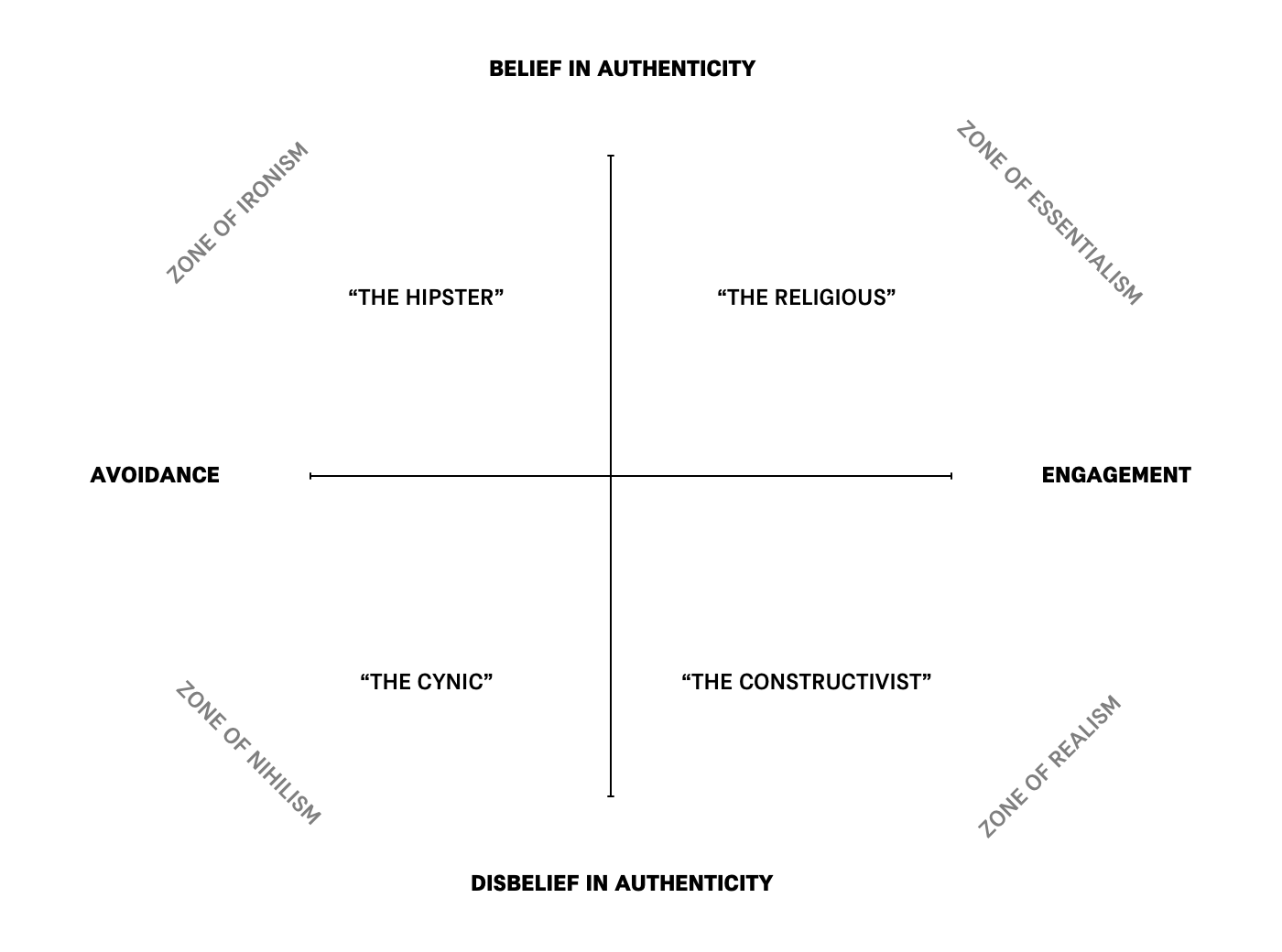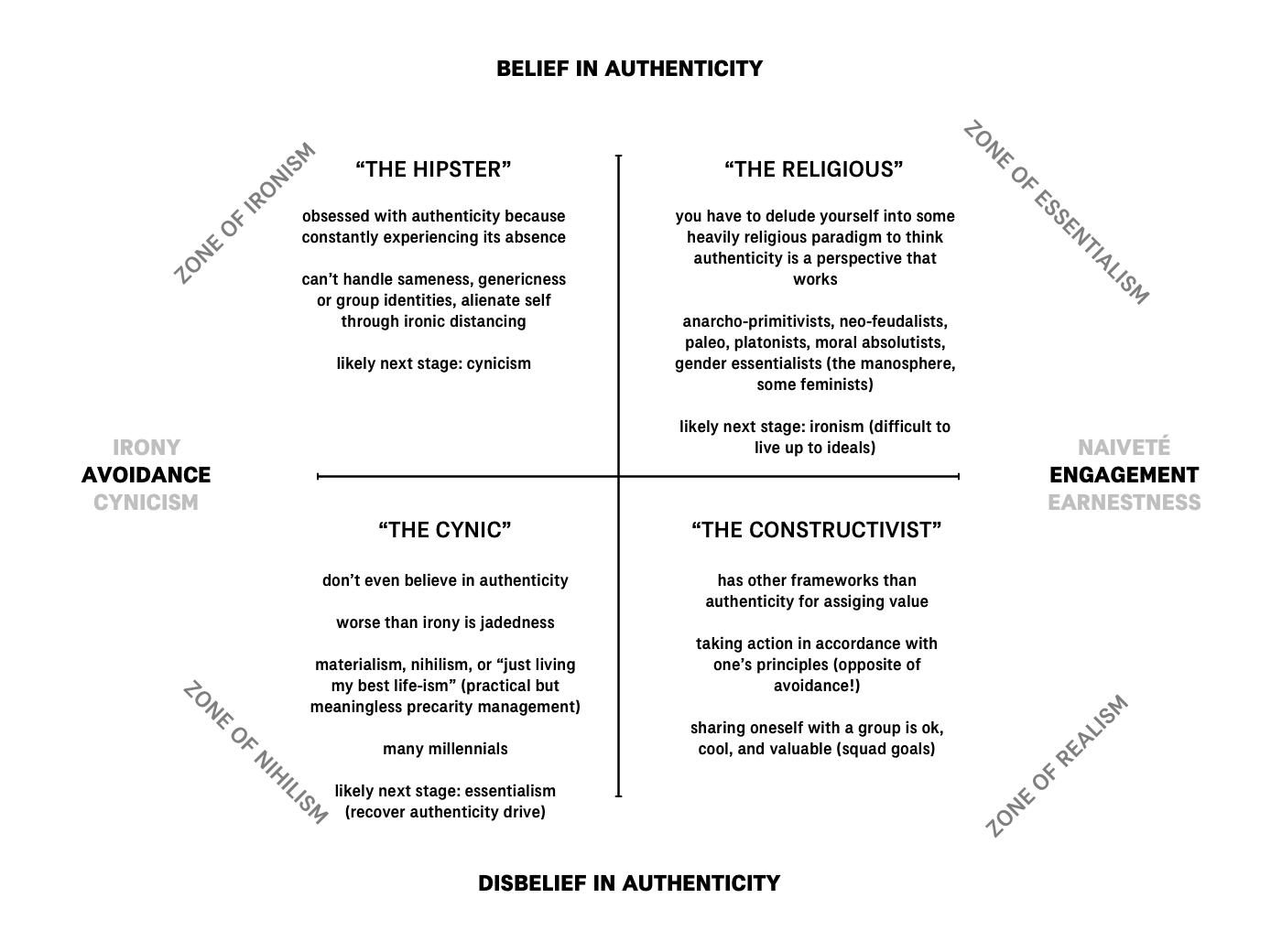We turn now from the the binary opposition “authentic / inauthentic” to the meta-level pair: “belief in authenticity / disbelief in authenticity.”
The only respect in which authenticity is “real” is that it is something that can be thought, felt, sought after, and argued about on the internet. But does it matter that authenticity doesn’t really exist? So many of us act and think as if it does, consciously and unconsciously. So whether we like it or not, we are implicated in authenticity, just as we are implicated in other social facts, such as God.
Similar to belief in God, belief in authenticity comes with a particular set of ethics. Similar to the way our personal relationships to religion structure how we think and feel about the world, so does our relationship to authenticity.

Belief in Authenticity
In the popular understanding of authenticity, something is authentic if it (A) is unique and (B) has not entered the sphere of commercial exchange. Beanie Babies and The Gap khakis are therefore out by definition—commodities are explicitly generic and have monetary value associated with them.
In After Authenticity, my analysis focused on commodity consumer goods because by looking at the marketing language and visual design of products it’s easy to see how these principles mutated into a mass-marketing visual aesthetic in the early 21st century. But not all commodities are products. Once you recognize a commodity as anything generic that can be exchanged on a market, you begin to see the broader ethical mandates of belief in authenticity.
- Music: small labels and indie bands good, pop music bad.
- Jobs: a flashy role as a startup “rock star” good, corporate drone job bad.
- Personal taste attributes: having specific or rarified taste good (even to the degree of intentionally liking unlikeable things), liking generic things bad.
- Space: hyperlocalism good, the global airportisation of urban environments bad.
- Beliefs: atheism good, religion bad—I’m not one of those sheeple!
- Identities: insisting on my individuality and nonconformance good, group identifications bad.
How many of these are familiar to you? In these common attitudes we can observe a regular moral framework, the authenticity value spectrum.

Staunch authenticity believers are in quite a tricky position. Everywhere we turn, the world is simply filled with generic commodities, from cheaply printed Gildan tees to mass-produced condominiums. What is an authenticity believer to do?
Avoidance and Irony
Until recently, the easiest and most common response to the commodity landscape was simply avoiding it. Purchasing locally-sourced goods or items that are ostensibly hand-crafted (or produced in a similar non-industrial fashion) are common ways to avoid commodities and preserve the idea of an authentic relationship to consumed items. This avoidance extends to intangible commodities like personal taste, such as deciding not to like a band anymore because other people now like it as much as you. Exceptions to this normative avoidance behavior have typically been granted on the conditions that a speaker publicly express their remorse for liking something generic or popular by invoking the idea of a “guilty pleasure.”
Of course, avoidance can only go so far. If you find commodities problematic but you live in a society of material abundance, you’re bound to run into problems. This is where irony comes in.
Some commentators have, inexplicably, treated the dual hipster obsessions of authenticity and irony as if they are irreconcilable. The distinction is false; irony is a natural stance to take when constantly making judgments between “real” and “fake,” authentic and inauthentic. It’s a coping mechanism for preserving one’s commitment to authenticity in the midst of a commodified and commoditized society. As Magill describes in his seminal work on irony, Chic Ironic Bitterness: distancing oneself from commodities through irony “helps ironists to view [commodity] places, items, and products as something not part of themselves.” This moral jiu-jitsu move is how hipsters were able to wear $5 shutter shades while maintaining that authenticity is real. Of course, irony cannot deal with any of the environmental or labor implications of a world organized around the production of commodities; the only thing that irony solves is salvaging people’s belief in authenticity.
While overt irony is no longer a popular attitude to display publicly, it is still a prevalent attitude towards the world, especially among millennials. If you are reading this, you likely grew up in an era in which irony was the primary way of engaging with the world. Not only did it have to do with goods, but was (and continues to be) pervasive in interpersonal relations. Asserting one’s individuality and refusing group labels on principle is not unique to hipsters but can be seen in dozens of other subcultures. It is part of an authenticity memeplex that includes dogmatic atheism, both classical and neo-liberalism, and modern relationship discourse. I suspect that American progressives’ failure to organize politically is in no small part due to the ingrained sense of “wrongness” that leftists feel when they are asked to be part of a collective.
To summarize: it is paralyzing and alienating to think authenticity is real but see everything around you as fake. What other choice do you have but to resign yourself to your fate? Irony is a way of shirking responsibility. It reifies the logic of authenticity while desperately asserting moral superiority. Obviously, this is not a sustainable position, which is why most ironists end up as jaded cynics.
Doubling Down On the Authentic
The more one tries to live up to the principles of authenticity, the harder it becomes to integrate with major portions of globalized society. At the extreme end of authenticity ethics we should therefore expect to find movements that are committed to heavily anti-commodity lifestyles. This commitment captures what I mean by “engagement” in my 2x2 above: it means acting on one’s principles (whether those are authenticity or something else).
Anarcho-primitivists and hunter-gatherer fetishists could be considered examples. Authenticity is not a stated value of these groups, but it intersects with their aspirations in an interesting way. A few readers pointed out that I didn’t mention Naomi Klein’s famous book No Logo. While I haven’t read it myself, I’m aware that it is canonical in the history of authenticity-infused reactions to late 20th-century mass culture. Klein’s book paints a picture of an authenticity movement developing its own forms of expression (culture-jamming, hyper-localism) in tandem with the anti-globalization, anti-corporatist movement. Importantly, this shows that authenticity overlaps with other moral assertions, such as environmentalism and liberalism.
While the commitment is admirable, the groups I mentioned are wildly ineffective at accomplishing their goals and have achieved only niche levels of membership. The insistence on hyper-localized efforts and an unwillingness to engage with the realities of post-industrial economics makes me suspect that authenticity is an implicit principle for these movements.
Post-authenticity culture is going to give us way better versions of post-capitalism
— Toby (@tobyshorin) May 16, 2018
Another variety of authenticity True Believer is the essentialist. The nostalgic essentialism of authenticity runs parallel to the nostalgic essentialism of the ethno-nationalist and modern chauvinist who advocates the “return of kings.” Each relies on the idea that people and things have immutable, intrinsic qualities—the “true self” or the cultural / ethnic / gender “reality”—which give them their value in the “natural order.” Note the reactionary nature of each of these agendas. “Authenticity” is not a neutral politics.
After Donald Trump’s election, a certain subset of left-leaning Americans were surprised to find that this essentialism, responsible for so much violence in the past, is not yet discredited. It is, however, this same class of people that now assigns value to people and goods by invoking the authenticity of their ethnic origin. Just as valuing authenticity led to hipster debates over which album was more obscure, it also leads to toxic cultural appropriation discourse and identity contests of the type we see played out on Twitter daily. And that isn’t the worst of it. In his new book Authentocrats, British cultural commentator Joe Kennedy lambasts so-called progressives for justifying neoliberal policies with references to pastoral traditionalism imputed to a fictional “real people” in the UK. The same game is afoot in the United States in the “coastal elite” / “heartlands” dialectic. To use Kennedy’s words, authenticity politics turns “very specific concerns about class and property into specious ones about cultural sovereignty.”
Authenticity is a normative belief, but it is not a centrist nor a universalist one. Committing further into it leads to extremism by definition. When faced with a seemingly intractable ethical quandary, it is rarely a good idea to double down on your values.
Disbelief in Authenticity
Disbelief in authenticity begins with the acknowledgement that something being a commodity does not make it intrinsically better or worse. Cynics who still mourn the ghost of authenticity turn to materialism and moral relativism in its absence. But if not cynicism, what else?

The Cynical Position: Nothing Is Authentic
The cynic correctly recognizes that authenticity doesn’t exist. In one sense, this is a positive development: cynics are post-irony, in that they do not need to maintain the hipster’s false consciousness. But the cynic doesn’t have another moral model yet. They still premise value on an authenticity that no longer exists, forcing them to conclude that everything is equally awful. In the vacuum of authenticity, no commodity, brand, or service seems more righteous than any other—and everything has been coopted by capitalism! This illustrates that being post-ironic is not the same as being post-authentic.
David Chapman has perfectly described this relationship between nihilism and true belief in his own work. It is characterized by flip-flopping between cynical despair and desperate belief in the authentic.
Not all post-ironists act cynical and jaded. in fact, they often come in the form of carefree consumers who either don’t have the energy to keep up ironic disgust with the world or who just think irony isn’t cool anymore. Interestingly, this has led to a sort of freedom of association that hasn’t been seen since the 90s, with consumers of all stripes inventing new lifestyle categories. Yet seeing all commodities as equally corrupt, perversely, makes all consumption equally permissible, quickly leading to a nihilistic materialism. Dena Yago has written about this extensively, warning that post-irony culture has failed to engage critically with consumption:
“This is done as an act of criticism, irony, or post-ironic sincerity, this last of which is often compounded with a sense of indignation along the lines of ‘So what if I love Doritos and Mountain Dew?’” Content Industrial Complex
“This sincerity has taken precedence over critique or resistance. Somewhere along the line it became acceptable to be authentic, earnest, honest, and sincere, even if the object of this sincerity is a complete celebration of consumerism.” On Ketamine and Added Value
Some people I know have called the “post-irony” position morally inept and intellectually lazy. I suspect this is largely a reaction to the naïve moral relativism implicit in the post-ironic consumption that Dena describes. Simply not giving a fuck is lazy, but armchair yelling about post-irony is no less cynical than going full hypebeast. Ironic and cynical attitudes are forms of disengagement that refuse to deal with the world as it really is. Unfortunately, nihilism is a natural conclusion to reach if another ethical framework is not adopted when belief in authenticity is abandoned.
The Constructivist Approach
It bears repeating once more that I have said nothing about what is authentic or inauthentic. I have only claimed that:
-
Belief in authenticity mandates a particular set of morals that are maladapted for today.
-
Belief in authenticity is an option.
The reason it’s difficult to escape the three moral positions elaborated above is because any middle point (ironism) along the traditional authenticity spectrum inevitably feels like a compromise, suggesting that the only valid positions are embracing authenticity nihilism or authenticity essentialism.

An object-level paradox can only have a meta-level solution. In our case, we need to leave belief in authenticity behind entirely and adopt different ethics and beliefs.

In After Authenticity I said “brands and commodities therefore need to be considered and critiqued on the basis of the specific cultural and economic contributions they make to society.” To expand on this: instead of falling back on the authenticity spectrum, we need to adopt evaluative methods that are targeted for their specific use cases. An example will clarify this proposal.
Recently I was asked about authenticity of supply and demand for virtual objects:
the distribution model (i.e. faucets and sinks in economics) of the physical world are what drive the value of objects (like, cost to produce, distance, etc). In virtual worlds these faucets and sinks are artificial (like apples only being able to be picked every 30 seconds), creating an artificial supply curve.
My question is: is the supply curve of real world assets authentic? I’d say yes. Is the supply curve of virtual assets authentic? I’m not sure, and I’d say it depends on how the economy is structured. An unregulated market that becomes a “perfect market” could be said to be authentic, even if the faucets and sinks of the assets are artificial (aka, I’m ok with the weird limitation on apple production, because those are the rules of the universe). But if the game has an NPC that sets a perfect price floor on apples (i.e. buying all of the apples forever at one price point), does that remove authenticity? Is it because our expectations of how a rational actor would behave are being broken?
From a place of suspicion about the whole authenticity model, this question becomes incoherent. The supply curve of virtual assets is not “inauthentic”—it is designed. If we are interested in understanding whether the system itself is good or bad, we have to drop the “authentic/inauthentic” binary and examine the system’s intentions. Does it accomplish its goals? What unexpected second-order outcomes does it have? From this perspective, the idea that the supply curve of real world assets is “authentic” also starts to look a bit silly. The value is not arbitrarily nor deterministically (“authentically”) set by the market (“the rules of the universe”); the supply chain, distribution model, logistic interfaces, materials, and consumer price points are all parameters that are equally subject to purposeful manipulation.
This anecdote contains two suggestions for how we can move on from authenticity. First, the word “authenticity” is loaded language and its casual use should be interrogated. Second, we must deploy targeted, contextual, and empirically measurable ways of evaluating good and bad. That means being explicit about what we value personally and what we want systems to do. A piece of art that speaks to you is not “authentic”—you appreciate it because you feel a way when you look at it, or because you value creative novelty. A brand is not “authentic”—the company either delivers or does not deliver on its promises of ethical labor practices.
Note that I have aligned this approach with constructivism. This is related to but not the same as deconstruction, the method most closely aligned with forms of critique that tend toward the nihilist perspective. I borrow the word not just for its more positive connotations but also its association with contemporary anthropology, the ethnographic and ethnomethodological playbooks in particular. To take an emic perspective on social systems means accepting the validity of local belief systems and not interpreting them within the terms of an outside moral perspective like authenticity. A constructivist attitude toward morality means it is legitimate to apply non-absolute value spectra to different situations.
Let’s keep things simple. Here’s a breakdown of post-authenticity politics presented in the ever popular broke/woke format, conveniently ready to be loaded into whichever dialectical meme template you like best.
-
Authenticity:
- All companies are evil.
- Critiquing brands because they’re “inauthentic.” Not believing in authenticity:
- Elaborating specific criteria for what initiatives I think companies should take to deserve my support and being public about them.
- Holding brands accountable to empirically-determined environmental, labor, and social practices and valuing them according to their performance.
-
Authenticity (ironism form):
- Judging people who like pop music, generic food, and other mainstream ephemera.
- Unconsciously referring to authenticity aesthetics to make judgments about what’s good and bad. Not believing in authenticity:
- Acknowledging that the production of goods with an authenticity aesthetic almost always relies on the same supply chains and energy production methods as regular FMCGs.
- Understanding that aesthetics can be produced at zero marginal cost and instead relying on measurable outcomes.
-
Authenticity (cynicism form):
- Lamenting how everything is coopted by commodity capitalism. Not believing in authenticity:
- Understanding the supply chain that supports my lifestyle and shifting it to one that aligns with my personal goals.
-
Authenticity (essentialism or cynicism forms):
- Consumption as a way of forming identity is intrinsically bad and a feature of late capitalism. Not believing in authenticity:
- Consumption is never going away, people have always used objects as meaningful group identity signifiers.
-
Authenticity (ironism/hipsterism form):
- Entitled special snowflake symptom, avoiding groups. Not believing in authenticity:
- Squad goals. Group identities give me meaning, community, and shared support. Design new collective myths and rituals.
Finally we have enough distance from the authenticity paradigm to see its politics, commitments, and ethics more clearly. But now that we know its implications, we have to decide whether we believe in it or not. There are many ways to relate to the world. Choose wisely.
